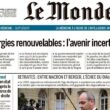Some 160 regional newspapers, magazines, printing and associated web sites are being sold in Australia by Nine Entertainment Co (NEC) which acquired Australian Community Media (ACM) as part of its A$4bn “merger” last year with Fairfax Media. It includes regional papers like Newcastle Herald, Canberra Times, The Examiner, Border Mail, The Courier and Illawarra Mercury, and farming publications The Land, Stock & Land, and Queensland Country Life. Final bids for ACM were made on Wednesday this week, in response to documents which show that the business can achieve A$8m cost savings in 2019 and a further A$7m in 2021. But it is not clear whether this is part of a reported plan also to reduce the regional newspapers’ headcount by 200 (about 10%).
In the first half of the 2019 financial year, ACM revenue was down 8% to $194.1m. Advertising revenue, at A$121.2m, was down 13%, and circulation was down 3% to $35.9m. EBITDA profit fell by 42% to $21m, expected to be A$44m for the full year. But some bidders are forecasting that, with cost savings and even allowing more revenue slippage, ACM could generate A$50m EBITDA by 2021.
After the sale, NEC will have three divisions: TV (Channel Nine and 9Now); Stan video streaming; and Newspapers (Sydney Morning Herald, The Age, and Australian Financial Review). NEC is also the majority shareholder in Domain property classifieds (which competes with News Corp’s REA Group) and in Macquarie Media, one of Australia’s largest radio networks.
Among the ACM bidders is former Domain CEO Antony Catalano (backed by the Thorney, an investment group owned by large-scale investor, philanthropist and sometime film producer Alex Waislitz). There are rival offers from private equity firms Allegro Funds, and Anchorage Capital Partners whose bid is reportedly led by the former SevenWest, ACP, and Bauer executive Nick Chan.
Catalano’s involvement has helped to focus attention on Domain, the A$1.8bn group which was separately IPOd by Fairfax in 2017. Bidders have been speculating that NEC might now seek to offload its 59% shareholding in Domain which has magazine links with many of the regional newspapers it is selling. Unsurprisingly, that speculation has swirled round Catalano who, having worked at Fairfax for 23 years (including as a property editor), became CEO and steered the de-merged company to its 2017 IPO, only to resign abruptly two months later. The scuttlebutt (in Fairfax’s own Australian Financial Review) linked the CEO’s departure with an alleged “boy’s club” culture of bullying in the company.
The speculation about NEC’s stake has helped to push up the Domain share price which, like the more international A$10bn REA Group, has been in the doldrums. News Corp owns 62% of REA and also 100% of Move Inc (which has 50m users in the US). The REA shareholding has a value equivalent to more than 50% of the US$7bn market cap of News Corp, owner of Wall Street Journal, The Times of London, The Australian The Sun, New York Post, Harper Collins, and Fox Sports. In Australia, where the Murdoch-controlled News Corp owns a regional newspaper network competing with ACM, its interests are broader than elsewhere and include Foxtel pay TV, Fox Sports and Sky News Australia. The country’s changed media ownership regulations (which allowed the NEC-Fairfax deal) might also permit News Corp acquisition of NEC’s primary competitor SevenWest.
But so much of the News Corp story is now about those growing digital real estate services which, in 2018, accounted for just 11% of revenues but 32% of its EBITDA. While news and information, subscription video, and books are almost equal contributors to the News Corp profit, digital real estate has superior margins, stronger growth rates – and better long-term prospects. So the whispers about NEC’s possible readiness to sell its Domain stake have inevitably led to speculation about a possible merger with Domain.
As it happens, News Corp has been talking to NEC in Sydney about a possible video streaming partnership between Foxtel and Stan (which was launched in 2015, now has 1.5m subscribers – 60% up in 12 months – and is forecasting a profit breakthrough this year). Stan is the main Aussie competition for Netflix and signed a content deal with Disney in December which, presumably, means that the Disney+ streaming service (launching in November) will not be competing in Australia.
So, that’s one fewer challenge for NEC which (with News Corp) can work out a 2019 TV-streaming deal and, perhaps, a digital property merger too. What price a REA-Domain-Move global combination?
For NEC, it all seems worlds away from 2006 when (along with ACP Magazines) it was acquired from the Packer family by CVC private equity for a disastrous A$5bn. The extravagant top-of-the-market deal was signed close to the 50th anniversary of Channel Nine’s launch of TV in Australia. But the celebrations didn’t last long and neither did the hapless executives who paid the price. Bauer bought the magazines. Having washed away CVC, NEC IPOd in 2013 and now has a market cap of A$3bn. It made 2018 (pre-Fairfax) revenue of A$1.3bn and EBITDA of A$257m. Classy drama in the AsiaPacific.




